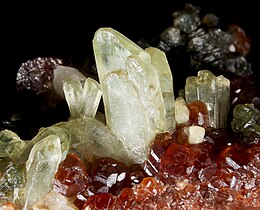
Back ديوبسيد Arabic Diopsid Azerbaijani Дыяпсід Byelorussian Диопсид Bulgarian Diòpsid Catalan Diopsid Czech Diopsid German Diopsido Esperanto Diópsido Spanish Diopsido Basque
| Diopside | |
|---|---|
 Diopside – Bellecombe, Châtillon, Aosta Valley, Italy | |
| General | |
| Category | Inosilicate mineral |
| Formula (repeating unit) | MgCaSi2O6 |
| IMA symbol | Di[1] |
| Strunz classification | 9.DA.15 |
| Crystal system | Monoclinic |
| Crystal class | Prismatic (2/m) (same H-M symbol) |
| Space group | C2/c |
| Unit cell | a = 9.746 Å, b = 8.899 Å c = 5.251 Å; β = 105.79°; Z = 4 |
| Identification | |
| Color | Commonly light to dark green; may be blue, brown, colorless, white to snow white, grey, pale violet |
| Crystal habit | Short prismatic crystals common, may be granular, columnar, massive |
| Twinning | Simple and multiple twins common on {100} and {001} |
| Cleavage | Distinct/good on {110} |
| Fracture | Irregular/uneven, conchoidal |
| Tenacity | Brittle |
| Mohs scale hardness | 5.5–6.5 |
| Luster | Vitreous to dull |
| Streak | white |
| Specific gravity | 3.278 |
| Optical properties | Biaxial (+) |
| Refractive index | nα= 1.663 – 1.699, nβ= 1.671 – 1.705, nγ= 1.693 – 1.728 |
| Birefringence | δ = 0.030 |
| 2V angle | Measured: 58° to 63° |
| Dispersion | Weak to distinct, r>v |
| Melting point | 1391 °C |
| References | [2][3][4] |
Diopside is a monoclinic pyroxene mineral with composition MgCaSi
2O
6. It forms complete solid solution series with hedenbergite (FeCaSi
2O
6) and augite, and partial solid solutions with orthopyroxene and pigeonite. It forms variably colored, but typically dull green crystals in the monoclinic prismatic class. It has two distinct prismatic cleavages at 87 and 93° typical of the pyroxene series. It has a Mohs hardness of six, a Vickers hardness of 7.7 GPa at a load of 0.98 N,[5] and a specific gravity of 3.25 to 3.55. It is transparent to translucent with indices of refraction of nα=1.663–1.699, nβ=1.671–1.705, and nγ=1.693–1.728. The optic angle is 58° to 63°.
- ^ Warr, L.N. (2021). "IMA–CNMNC approved mineral symbols". Mineralogical Magazine. 85 (3): 291–320. Bibcode:2021MinM...85..291W. doi:10.1180/mgm.2021.43. S2CID 235729616.
- ^ C. D. Gribble, ed. (1988). "The Silicate Minerals". Rutley's Elements of Mineralogy (27th ed.). London: Unwin Hyman Ltd. p. 378. ISBN 0-04-549011-2.
- ^ Mindat page for Diopside
- ^ Handbook of Mineralogy
- ^ M M Smedskjaer; M Jensen; Y-Z Yue (2008). "Theoretical calculation and measurement of the hardness of diopside". Journal of the American Ceramic Society. 91 (2): 514–518. doi:10.1111/j.1551-2916.2007.02166.x.
© MMXXIII Rich X Search. We shall prevail. All rights reserved. Rich X Search